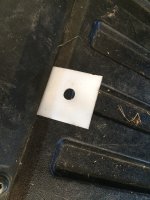Mine is the DC long bed, so it should be the worst offender. I haven't tried that ^ trick, but right after I bought it and headed south on the 25 in Denver, it bucked like a frickin' bronco. If I had to drive that road very often (or one like it), no way in hell would I own this truck.
It's weird, because a C channel is better optimized for vertical stiffness that a boxed frame. The wimpy part of the frame is the rear 6'. And the beefy hitch surely stiffens the last 2'. The C is only 5.5" tall and 3.2" wide back there... and .16" thick. I don't know how that compares to other frames.
The rest of the frame that is closed C on mine is 7"x3.2" and it looks like the same thickness, with an additional C channel riveted in the top and bottom of that, so .32" thick top and bottom. That's well optimized for vertical stiffness... I'll take a WAG and say it's 3-4x stiffer than the rear part.
Nearly everything is riveted or bolted which led me to think it was a special high strength steel... but the front bed mounts and the shock mounts are welded in place for some reason. At any rate, these frames aren't lacking in strength based on the abuse that they are able to survive, but some added stiffness would be nice.
It wouldn't be that hard to do. Bolt or rivet or weld pieces of channel to the outside of the frame, then form lengths of flat steel to match up with them on the top and bottom. Since I took the bed off, I have plenty of room....






